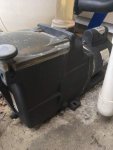I've been reading TFP posts about getting the smallest pump with the biggest filter for the cleanest water and best efficiency, and I need advice. I'm ready to get a new filter (current Hayward S200 leaks due to hairline cracks around the dome, and Hayward no longer sells just the top half). I would like to buy the biggest sand filter I can, because we have fine silt that our filter can't clear without added DE, and I believe a bigger filter will help with that. (We're also have problems with rust-colored dust returning to the pool after the pump has been off, which hopefully will be solved by the new filter.)
Pump specs:
AOSmith Century Centurion B128
1 HP, 1.40 SF, 1 PH
60 HZ, 3450 RPM, 230/115 volts, SF7.2/14.4 amps
It has just one speed.
Our piping is 1 1/2" and we have a Jandy Legacy LRZ gas heater. That's it -- no fountains, spas, slides.
Please help. I tried reading the hydraulics sticky on the subject and it's way over my head. Pool stores are recommending filters by sand amount, suggesting I go with a 250# sand filter. I think I want more cleaning ability. Thanks in advance!
Pump specs:
AOSmith Century Centurion B128
1 HP, 1.40 SF, 1 PH
60 HZ, 3450 RPM, 230/115 volts, SF7.2/14.4 amps
It has just one speed.
Our piping is 1 1/2" and we have a Jandy Legacy LRZ gas heater. That's it -- no fountains, spas, slides.
Please help. I tried reading the hydraulics sticky on the subject and it's way over my head. Pool stores are recommending filters by sand amount, suggesting I go with a 250# sand filter. I think I want more cleaning ability. Thanks in advance!



